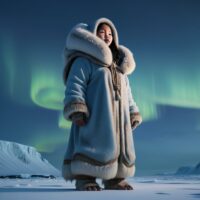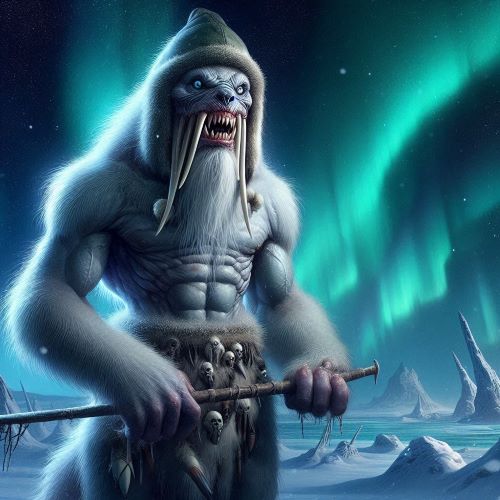Inugpasug : The Giant Geographer
Listen
At a glance
| Description | |
|---|---|
| Origin | Inuit Mythology |
| Classification | Hybrids |
| Family Members | N/A |
| Region | Canada, Alaska, Siberia, Greenland |
| Associated With | Geography, Strength, Stealth |
Inugpasug
Introduction
Inugpasug, sometimes spelled Inupasugjuk, are towering beings from Inuit mythology whose stories echo through the icy winds of the Arctic. These enigmatic giants are deeply woven into the oral traditions of Inuit communities across Alaska, northern Canada, Greenland, and parts of Siberia. Revered and feared, Inugpasug stand apart from other mythological figures by embodying the immense, untamed forces of nature itself. Unlike gods who rule or spirits who guide, they are considered powerful, unpredictable entities whose very existence reflects the scale and mystery of the Arctic landscape.
They are not frequently depicted in visual art or literature, making their legend more elusive than many other figures in Inuit cosmology. Instead, their tales live primarily in the spoken word, shared between generations as cautionary tales, cultural memory, and spiritual reflection. The Inugpasug are not simply folklore characters—they are living symbols of how the Inuit perceive their environment and their place within it.
Physical Traits
The defining characteristic of the Inugpasug is their colossal size. These beings are said to be so immense that they can wade into the Arctic Ocean and pluck whales from the water as easily as one might catch fish. Their footprints, called inukpasugjuit, are believed to remain imprinted across the tundra, frozen in time and landscape. Unlike monstrous giants from other traditions, Inugpasug are not necessarily grotesque. Their features are humanoid, though greatly exaggerated. They often wear traditional Inuit garments, making them resemble supersized versions of the Inuit themselves, blurring the line between human and myth.
Interestingly, the gender dynamics of these giants are an essential part of their mythos. Male Inugpasug are said to be exceptionally rare—perhaps even unseen in living memory. Female Inugpasug, however, appear more frequently in stories, often exhibiting curiosity toward humans. They are described as carrying people in their amoutiqs—Inuit baby carriers—suggesting a strange blend of affection and danger. Though not usually hostile, their sheer size makes them formidable and sometimes perilous to encounter.
Family
There is no well-documented family lineage or creation myth associated with the Inugpasug. Instead of existing within structured family systems, they are often seen as lone figures or as manifestations of the Arctic itself. In some traditions, Inugpasug is considered the brother of Nunam, whose husband is Sila, the god of wind and weather. This familial connection introduces the idea that these giants are not just physical beings but are linked to broader cosmic forces.
Sila, as a powerful weather spirit, is sometimes said to have slain Inugpasug, placing him in the realm of beings who interact directly with the forces that shape life in the Arctic. However, these stories do not establish a divine family tree in the traditional sense. Rather, the Inugpasug’s family connections emphasize the fluidity of Inuit cosmology, where spiritual beings interact not as rigid hierarchies but as interconnected elements of nature and belief.
Other names
The name Inugpasug or its variant Inupasugjuk is the most common identifier for these northern giants. However, due to the oral nature of Inuit storytelling and the linguistic diversity among Inuit communities, different regions may use alternate terms or descriptors. Some English translations refer to them as “Northern Giants,” a name that captures their essence but misses the cultural depth of the original term.
Another term that appears in Inuit writings is Angijuutialuujut, which may refer to beings of great size or importance. This descriptor aligns with how Inugpasug are viewed—more than mere physical entities, they are spiritual markers of something immense and unknowable. It’s important not to confuse Inugpasug with similarly spelled words from other cultures, such as “Impasug-ong,” a municipality in the Philippines that shares phonetic similarities but has no relation to Inuit mythology.
Powers and Abilities
Inugpasug are not known for wielding magical powers in the sense of spells or supernatural manipulation, but their immense physical capabilities make them extraordinary. Their ability to capture whales by hand suggests a command over nature that few beings possess. This natural strength, combined with their mysterious presence, paints them as more than just giants—they are part of the land and sea themselves.
The label “divine geographer” is sometimes associated with Inugpasug, hinting at a deeper role in shaping the Arctic landscape. This could mean that their movements and actions are responsible for forming geological features or that they once roamed the world during a time of creation. In this way, they resemble other foundational figures in mythology who sculpt the world through their presence. Though not shamanic in nature, their aura and scale suggest spiritual authority, placing them within the broader framework of Inuit beliefs that include the angakoq (shamans) and the Master of Spirits.
Modern Day Influence
Despite the mystique surrounding the Inugpasug, they have not gained the same level of attention in contemporary media as other mythological beings. However, they continue to live on in oral storytelling traditions passed down in Inuit communities. These stories function not only as entertainment but also as cultural education, reinforcing values such as respect for nature, humility before the unknown, and the significance of heritage.
Inugpasug are also beginning to find a place in modern reinterpretations of Inuit mythology. Projects like the Nunavut Animation Lab have worked to visualize traditional Inuit stories for younger audiences, and it’s not impossible that figures like Inugpasug could feature more prominently in future creative works. Online platforms such as Mythlok are also helping to raise awareness of lesser-known mythological figures, ensuring that giants like Inugpasug are remembered beyond the Arctic.
Academic interest in Arctic folklore has also begun to include Inugpasug in discussions of indigenous spiritual geography. These studies view the giant not just as a myth but as a cultural response to the scale and sublimity of the northern environment. In this context, Inugpasug becomes a symbol of how people relate to the land—both with awe and with caution.
Related Images
Source
InuitMyths.com. (n.d.). Inupasugjuk. Retrieved from https://inuitmyths.com/inupasugjuk.htm
The Canadian Encyclopedia. (2023). Inuit Traditional Stories. Retrieved from https://www.thecanadianencyclopedia.ca/en/article/inuit-myth-and-legend
Mythologis. (n.d.). Inuit Mythology and Culture: Echoes of the Arctic. Retrieved from https://mythologis.com/blogs/inuit-mythology/inuit-mythology
Cultural Survival. (2010). Being Indigenous in the 21st Century. Retrieved from https://www.culturalsurvival.org/publications/cultural-survival-quarterly/being-indigenous-21st-century
Balladeer’s Blog. (2012, May 18). INUIT DEITY: INUGPASUG. Retrieved from https://glitternight.com/2012/05/18/inuit-deity-inugpasug/
Bjerregaard, P., & Seersholm, F. (n.d.). The Legend of Qajuuttaq: Exploring the Potential of Inuit Oral History in South Greenland.
Gosse, P. (n.d.). The ‘Third Gender’ of the Inuit.
Gubser, M. (n.d.). Inuit Theatre: Dramatizing the Myths.
Inhabit Media. (n.d.). Tales from the Tundra: A Collection of Inuit Stories. Retrieved from https://www.inhabitmedia.com/products/tales-from-the-tundra
Nielsen, A. L., & Oosten, J. G. (n.d.). Blessings and Horrors of the Interior: Ethno-Historical Studies of Inuit Perceptions Concerning the Inland Region of West Greenland. Retrieved from https://www.semanticscholar.org/paper/Blessings-and-Horrors-of-the-Interior%3A-Studies-of-Nielsen-Oosten/d7e5d8a980757a7018c12239d5e3c783636f2f21
Study.com. (n.d.). Inuit Mythology | Gods, Monsters & Origin Story – Lesson. Retrieved from https://study.com/academy/lesson/inuit-mythology-gods-monsters-origin-story.html
The Canadian Encyclopedia. (n.d.). Inuit Traditional Stories. Retrieved from https://thecanadianencyclopedia.ca/en/article/inuit-myth-and-legend
Frequently Asked Questions
What is lorem Ipsum?
I am text block. Click edit button to change this text. Lorem ipsum dolor sit amet, consectetur adipiscing elit. Ut elit tellus, luctus nec ullamcorper mattis, pulvinar dapibus leo.
What is lorem Ipsum?
I am text block. Click edit button to change this text. Lorem ipsum dolor sit amet, consectetur adipiscing elit. Ut elit tellus, luctus nec ullamcorper mattis, pulvinar dapibus leo.
What is lorem Ipsum?
I am text block. Click edit button to change this text. Lorem ipsum dolor sit amet, consectetur adipiscing elit. Ut elit tellus, luctus nec ullamcorper mattis, pulvinar dapibus leo.
What is lorem Ipsum?
I am text block. Click edit button to change this text. Lorem ipsum dolor sit amet, consectetur adipiscing elit. Ut elit tellus, luctus nec ullamcorper mattis, pulvinar dapibus leo.
What is lorem Ipsum?
I am text block. Click edit button to change this text. Lorem ipsum dolor sit amet, consectetur adipiscing elit. Ut elit tellus, luctus nec ullamcorper mattis, pulvinar dapibus leo.







